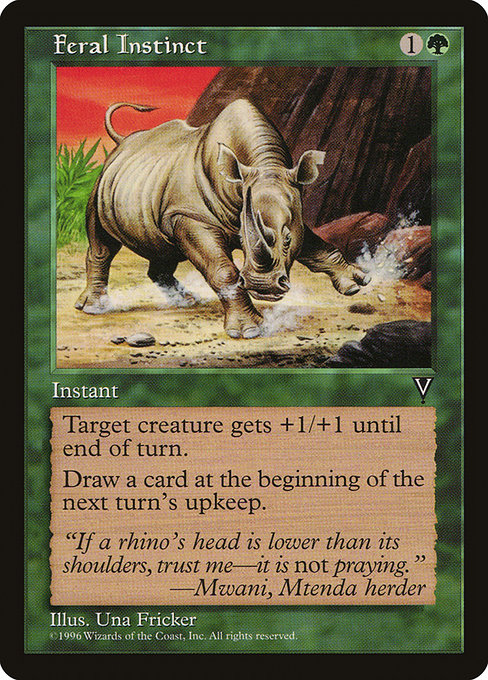
Image courtesy of Scryfall.com
Alt Art Frames for Feral Instinct: A Side-by-Side Look
Magic: The Gathering has always offered fans the thrill of alternate frame art versions, a playful reminder that a card’s presentation can shift the entire mood of a spell. Feral Instinct, a green instant from Visions released in 1997, is a compact lens into that design philosophy. With a cost of {1}{G} and the instantaneous power to buff a creature by +1/+1 until end of turn while drawing you a card at the start of your next turn’s upkeep, it’s a two-for-one that rewards tempo and planning. The question is less about what the card does and more about how the frame you see it in can color your perception of the moment 🧙♂️🔥.
In its original 1997 print, Feral Instinct rides the classic Visions frame—bold black border, compact rules text, and a flavor of the era’s tactile buttoned-down readability. The card’s type is Instant, its colors are green, and its rarity is common, with that familiar economy of front-and-center artwork and small-print flavor. The mana cost is deceptively simple for what it achieves: a quick combat trick that can swing a single creature’s survivability while replenishing your grip for the next few moves.
“If a rhino's head is lower than its shoulders, trust me—it is not praying.” —Mwani, Mtenda herder
Now, imagine comparing that same card across two paths of art direction. A side-by-side view isn’t just about pretty pictures; it’s about whether the green in the frame feels cooler or warmer, whether the border emphasizes the spell’s speed, and how much space the flavor text gets to breathe. Alt art frames often play with those subtleties. Some versions push a brighter forest-green hue, others pull a deeper, more muted tone. Some frames widen the text box to foreground the card’s mechanical parts, while others tuck rules text a touch tighter to foreground the artistry. These shifts don’t just aestheticize a card; they influence how easily you read the card in the heat of play and how the art settles in your memory during long drafting sessions 🎨🎲.
From a gameplay standpoint, Feral Instinct remains a lean, tempo-friendly spell. The target creature +1/+1 until end of turn can turn a fragile attack into a winning stab, especially when paired with an aggressive board or a protective alpha strike. The “draw a card at the beginning of the next turn's upkeep” clause is the kind of delayed payoff that rewards careful sequencing. The interplay between immediate board presence and the next-turn card draw makes it a microcosm of green’s classic balance between pressure and resources. In a side-by-side frame, you might notice how the card’s readability is affected: a frame that tightens up the text area can speed decision-making, while a looser, art-forward frame might invite a slower, more reflective read—perfect for nostalgia, or for those moments when you’re savoring Una Fricker’s illustration and Mwani’s herder flavor line with a coffee in hand ☕🧙♂️.
Beyond the table, alt art frames can become a conversation piece for collectors and players alike. Visions cards carry a specific historical weight—their frame design speaks to a time when MTG was still forging its identity in the market—and that aura can elevate the perceived value of a common card when paired with a rarer or alternate presentation. Feral Instinct’s actual print in Visions sits as a nonfoil, black-bordered piece with a familiar look that modern MTG designers nod to when they reflect on the franchise’s past. The precise art direction, the balance of green’s vitality, and the flavor text all contribute to a layered memory: a reminder that even a humble instant can carry a story about how a game visually evolves while keeping its core mechanics intact 🧩💎.
For readers who want to explore this topic further, the best way to engage is to compare the variants in person or through trusted image archives. Look for how the greens shift under different lighting in the artwork and how the border width interacts with the card’s readability during a tense moment. It’s a small study in craft—one that MTG fans return to with a sense of delight and a wink at the game’s enduring history ⚔️🎨.
And if you’re diving into MTG gear beyond the cards themselves, a little practical carry-all can help you stay ready for those alt-art debates and weekend tournaments alike. Speaking of practical gear, if you’re hunting for everyday tech that keeps your cards protected on the go, this magnet-equipped MagSafe phone case doubles as a card holder and comes with impact resistance in durable polycarbonate. It’s a thoughtful companion for fans who like to carry a few favorite pieces of the multiverse with them, card art included 🧙♂️💎.
Magsafe Phone Case with Card Holder - Impact Resistant Polycarbonate
More from our network
- https://blog.digital-vault.xyz/blog/post/meaning-of-missing-data-reveals-a-blue-star-82000-light-years-away/
- https://blog.digital-vault.xyz/blog/post/season-of-weaving-the-illustrators-magic-history-legacy/
- https://crypto-acolytes.xyz/blog/post/parallax-errors-shape-distance-to-a-blue-hot-star-at-18-kpc/
- https://transparent-paper.shop/blog/blog/post/creating-pixel-art-assets-a-guide-for-game-developers/
- https://blog.rusty-articles.xyz/blog/post/hot-blue-white-star-reveals-hidden-stellar-streams-in-sagittarius/